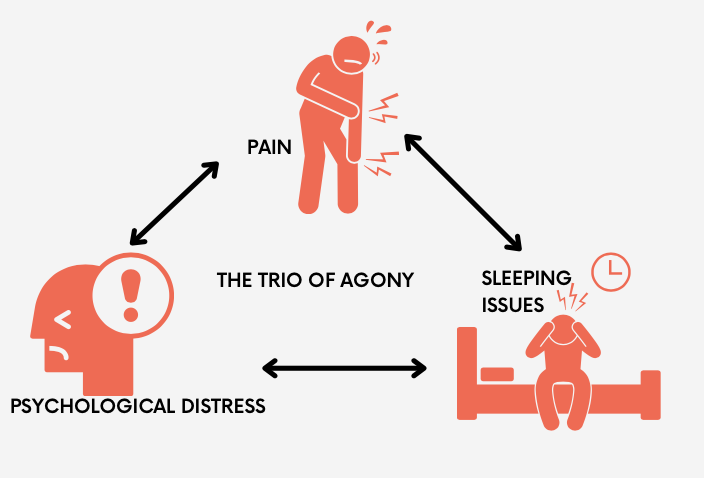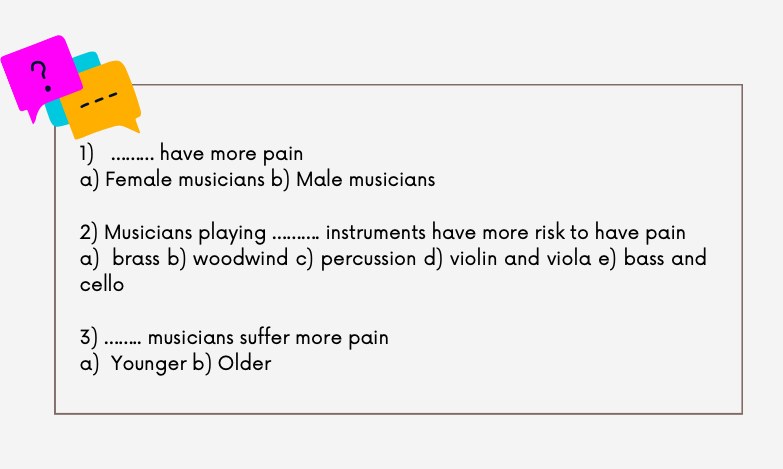By Irem Eliassen
For classical music lovers, agony is not the first thing that comes to mind thinking about orchestra musicians unless it's notes from a heart-wrenching piece tearing at your heart. Sadly, research shows that orchestra musicians repeatedly face various and severe pains in their bodies (1). Since their identities are so interconnected with playing (2), muscle pain and injuries have serious consequences disturbing their total wellbeing, and yet there are hardly any injury prevention programs for them.
Our researchers asked 358 orchestra musicians working across 8 different orchestras in Norway about whether they had experienced pain in the last 30 days in various body parts. At the same time, the survey also contained questions about their job demands, mental health, sleeping quality and daily life habits to examine the impact of pain on musicians’ wellbeing. Results revealed that approximately 85% of musicians suffered different degrees of pain. There is no wonder that playing an instrument for several hours in asymmetric body postures with repetitive movements increases the risk of injury, but this may be just the tip of the iceberg.
The aim of this essay is to increase awareness of musicians’ health; those things left hidden often hurt more. Let’s have a closer look at the impact of pain on orchestra musicians’ health in Norway.
This recent study from Norway reveals the magnitude of the problem; approximately 305 of 358 musicians reported pain, and 22% of those were heavily bothered by this pain. They had mainly pain in the upper back, neck and shoulder regions. Unfortunately, 15% of them reported suffering pain in almost the whole body.

Our researchers also demonstrated an entangled relationship between pain, sleep and mental health. Increased sleep and psychological disturbances were observed among musicians with pain. The greater the severity of pain was, the greater the disturbances they experienced, and vice versa. Voila! Here, we present to you a trio of agony. Previous research has suggested that the interrelationship between this trio may cause chronic pain.
Sleep is an essential part of our life and has a great impact on promoting our well-being. Research has proven the role of sleep on immune control, learning, memory processes and emotion regulation (3). So, how someone feels and thinks the following day can be dramatically affected by their prior night's sleep. Depression and anxiety are strongly associated with poor sleep. Even more dramatic, poor sleep is directly linked to stroke, heart disease and death (3).
The experience of pain is unpleasant for most of us; however, it is an essential feeling that is necessary to detect damage and threats to our existence. It warns and protects us so that we can avoid further damage. Sleep and pain have shown an interactive relationship; loss of sleep increases the pain, and increased pain disturbs the sleep. Mood and cognitive factors have effects on modulating this sleep-pain relationship. Here in its entirety is the trio of agony.
In addition to physical suffering, professional musicians are highly vulnerable to mental health disturbances. Symptoms of psychological disturbances such as anxiety and depression were observed in up to 39% of professional musicians (4). Fatigue, fear, anger, social avoidance and sadness are some of the psychological distress symptoms. However, because of psychological distress, physical symptoms called somatization may also appear. Headaches, ache in muscles, chest pain and dizziness are some of the somatization signs. Whether the pain occurs due to somatization or due to increased physical load, poor management of pain may lead to more psychological disturbances by increasing worries and decreasing the mood.
This research from Norway analysing orchestra musicians’ health also demonstrated the close relation between sleep physical and mental health. This link should be kept in mind when designing effective treatment or injury prevention programs for musicians. A program only targeting one may be less effective than a program targeting all the members of this agony trio.

Besides the impact of pain on wellbeing, our researchers also explored whether the occurrence of pain varied according to age, gender, or instrument group among orchestra musicians in Norway. Take a guess:

Well done! Let’s compare your results to previous research. Keep in mind this is a simplification of the research but it captures the main points. There are several studies demonstrating that female musicians experience more pain than their male colleagues. Upper string (violin and viola) musicians are expected to encounter injuries more often than other instrument groups. Regarding the age group, there are some conflicting results. Some research found both younger and older groups of musicians were at risk of more frequent problems; however, other studies could not manage to find any differences between groups.
There was no difference between age, gender or instrument group regarding the occurrence of pain and intensity of pain among orchestra musicians in Norway. This means that the problem was almost evenly distributed between different instruments, age and gender groups. However, it seems that this study only investigated occurrence of pain without looking at specific pain areas. Let’s put our critical glasses on; specific pain areas might show important differences between groups. That the researchers didn't consider specific body areas can be seen as a weakness of this study. For example, a brass player may complain of pain in facial muscles while a violin player has wrist pain. This is just an assumption since researchers did not examine that, we cannot know.
The second weakness of this study was that no questions were asked about pain in the face and jaw area. Brass and woodwind players are known for having muscle aches around their mouths. So, we can assume that occurrence of pain may be even higher than demonstrated in the research.
Despite the weaknesses, this research points out clearly body aches are a vast concern disturbing musicians’ wellbeing. Understanding underlying risk factors can guide the health care practitioners to find effective solutions to prevent injuries. Defining the problem as clearly as possible is an important step in finding a solution.
A world without music cannot be imagined; it is in every part of our lives. Aside from its entertainment value, music has enormous positive effects on mental health, regulation of emotions and even boosting the immune system. While we are enjoying the health boosting benefits of music, we owe our musicians providing them the health care they need.
Also, musicians’ injuries have shown to be complicated; more than one structure such as tendons, muscles, nerves and joints may be affected at the same time. Especially if the problems become chronic, it can be challenging to find effective treatment. Since musicians have very specific job demands depending on their instrument, treatment has to be adjusted to their needs. The effort of understanding musicians’ injury mechanisms may help health care providers think outside the box to find effective practical solutions.
Increasing awareness is an important step in this battle with the trio of agony. Especially, in competitive and perfectionist communities like that of classical music culture, injuries may be identified as signs of weakness or failure (5). These kinds of attitudes towards pain push musicians to perform through pain leading to persistent problems. No pain, no gain culture that focuses on chasing after perfect sound with flawless precision rather than spreading healthy musicianship causes harm. Therefore, special injury prevention programs should be accessible to musicians to increase knowledge about how to manage unique challenges they face. There is a lack of prevention programs for musicians, but when it comes to our athletes, almost every sports club has their own health team. Let’s give our musicians the same opportunities and protections as our athletes.
Our musicians bear this agony to be able to give us the music experience we love. So, at the next concert, let's clap them extra long and hard to show our gratitude and our support. Maybe then “no pain, no gain” gives it place to “no pain, lots of gain”.






